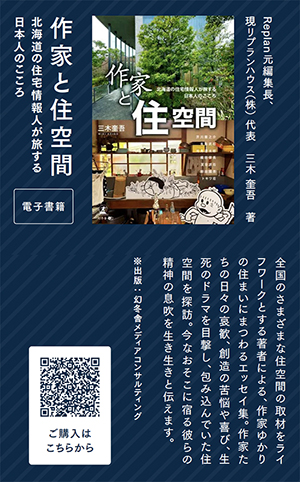
創作者にはその人生を賭けて追究する大テーマ「始原の感覚」というものが存在するだろうと思う。内面世界においてそここそが出発点だと見えてくる「原風景」。
この水木しげるの世界観を探訪してみて、その根っこにある妖怪譚への根掛かりの思いの強さを感じ続けていた。まるでスサノオの神話研究で出現する「根の国」とも通ずるような民俗がそこに集中しているように感じさせられるのだ。同じ中国地方出身・兵庫県中西部の福崎で出生した柳田國男は、成長過程で千葉県西部で過ごしていた時期に民俗学の創始に至る印象的な神秘体験をした。一方対比的に、民俗としての妖怪譚に魅入られた水木しげるは、その導師として「のんのんばあ」との出会いが強烈だったのだろう。
図は「水木しげる記念館」パンフからと、柳田國男の国会図書館・肖像記録。

この水木の妖怪譚世界を知るほどに、わたし的には柳田國男が発掘した「遠野物語」との深い同質性を感じさせられている。拙書のなかでも触れたけれど柳田が12-3歳の頃、寄留していた小川家旧宅にあったヒスイ玉を盗み見たときに、ある天啓のような目眩・ショックを受けてしまった故事との同質性を感じざるを得なかった。
水木しげるの場合、地域に残り伝えられてきた「妖怪譚」を強烈に伝授された。のんのん(仏)ばあとは近所の「拝み屋」(霊媒を生業としているものの蔑称。霊媒師、霊能者等。)とされる。武良家という地域の有力者の次男坊としての暮らしの中で、この地域の、神話世界「根の国の世界」とも通底している妖怪譚に根源的な興味を叩き込まれたのだと思う。女性の愛を底に持って包み込むように導かれたことは少年・水木しげるにとって独自の「根の国」観を育てていったのだと想像できる。
わたし自身は中国地方、それも山陽地域に血の出自を感じている北海道人だけれど、ある部分ではこのような「根の国」観には郷愁にも似たものを感じさせられる。また、スサノオ神話の持つ暴力性・異様さが妖怪譚と通底しているとも感じさせられる。まぁいまはあくまで印象だけれど。・・・
●お知らせ
拙書「作家と住空間」幻冬舎から電子書籍で発刊
お求めはAmazonで。
https://amzn.asia/d/eUiv9yO

English version⬇
Nonnonbhato “Nenokuni” & Folklore: Meeting Shigeru Mizuki - 3]
I feel a ‘connection’ between the mythological world of Susanoo's “Nenokuni” and yokai tales. And it may be connected to Kunio Yanagida's “folklore” as well. ...
I believe that there is a great theme, “the sense of origin,” that creators pursue with their whole life. The “primordial landscape” that appears to be the starting point in the inner world.
In this exploration of Shigeru Mizuki's worldview, I kept feeling the strength of the rootedness of his desire for yokai tales. It is as if there is a concentration of folk customs there that can be likened to the “root country” that emerges in the study of the myth of Susanoo. Kunio Yanagida, who was born in Fukusaki in midwestern Hyogo Prefecture, also from the Chinese region, had an impressive mystical experience that led to the founding of folklore during the time he spent growing up in western Chiba Prefecture. In contrast, Shigeru Mizuki, who was fascinated by yokai tales as folklore, had a powerful encounter with “Nonnomba” as his guide.
The figure is from the pamphlet of “Mizuki Shigeru Memorial Museum” and the portrait record of Kunio Yanagida at the National Diet Library.
The more I learn about Mizuki's world of yokai tales, the more I feel a deep similarity with the “Tales of Tono” that Kunio Yanagida unearthed. As I mentioned in my book, when Yanagida was 12 or 3 years old, he stole a jade ball from the Ogawa family's old house where he was staying, and I couldn't help but feel a similarity with the story of how he received a dizzying shock like a revelation.
In the case of Shigeru Mizuki, the “yokai tale” that remained in the region and had been handed down to him was passed down to him with great intensity. The “Nonnon (Buddha) Baba” was a “worshipper” (a derogatory term for those who make their living as mediums, such as mediums and psychics. It is said that he is a “medium,” “psychic,” etc.). The name “NONNON (Buddha)” is said to be a derogatory term for those who are engaged in mediumship. I believe that in his life as the second son of a powerful family in the area, the Takura family, he developed a fundamental interest in the tales of yokai, which have a common thread with the mythical “world of the root country” in this area. I can imagine that the boy Shigeru Mizuki developed his own unique view of the “Land of Roots” when he was guided to embrace the love of women at the bottom of his heart.
Although I myself am a Hokkaido native with blood ties to the Chugoku region, particularly the Sanyo area, this view of the “land of roots” makes me feel a certain amount of nostalgia. I also feel that the violence and strangeness of the myth of Susanoo has something in common with yokai tales. Well, this is just an impression. I am just giving my impression for now.
My book “The Writer and the Living Space” is published by Gentosha as an e-book.
Please visit Amazon for more information.



























※コメント投稿者のブログIDはブログ作成者のみに通知されます